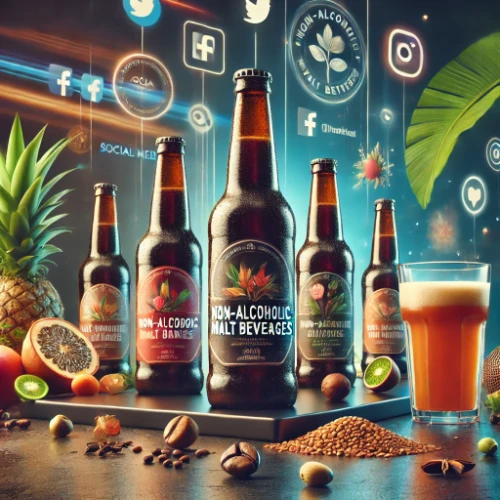Non-alcoholic malt has a fascinating history that spans centuries, evolving from a medicinal remedy in medieval times to a popular health drink today. This transition highlights not only the lasting impact of malt on health but also its cultural significance worldwide. Understanding its journey helps us appreciate how it has become a staple in modern wellness.
The Origins of Non-Alcoholic Malt: A Medieval Medicine
In medieval Europe, non-alcoholic malt emerged as a remedy for various ailments. Doctors at the time believed that malt could restore energy and improve digestion. It played a crucial role in humoral theory, the medical belief that balancing bodily fluids was essential for health. Therefore, malt became a popular prescription for fatigue, malnutrition, and digestive problems.
Barley: The Key Ingredient
Barley, the main component of malt, was rich in vitamins, minerals, and fiber. This made it valuable not just as a food source but as a medicinal drink. Moreover, barley’s nutrients were transformed during brewing, making it easier to consume. As a result, medieval physicians often prescribed malt drinks to patients who needed a nutrient boost or digestive aid.
From the Middle Ages to the 19th Century: Transformation of Malt
As brewing techniques advanced in the 19th century, malt shifted from being viewed as medicine to a regular beverage. In particular, non-alcoholic malt began gaining popularity, enjoyed for both its taste and nutritional value. Breweries started experimenting with different ingredients like vanilla and cocoa, offering new flavors that made the drink more enjoyable.
Non-Alcoholic Malt Around the World: A Global Phenomenon
The appeal of non-alcoholic malt expanded beyond Europe. Countries across Africa, the Caribbean, and Latin America embraced it not only for its health benefits but also for its cultural significance.
Non-Alcoholic Malt in Africa
In countries like Nigeria and Ghana, non-alcoholic malt became a popular choice at social gatherings. Its energizing properties, combined with its role in digestion, solidified its place in African dining culture. Malt drinks are still commonly served during family meals and special occasions.
Non-Alcoholic Malt in the Caribbean and Latin America
Similarly, in the Caribbean and Latin America, non-alcoholic malt grew in popularity during the 20th century. In places like Venezuela and Puerto Rico, malt became a family beverage. It was also incorporated into various desserts and snacks, enhancing its versatility.
The Science Behind Non-Alcoholic Malt: A Nutritional Powerhouse
Today, science backs up what ancient physicians believed—non-alcoholic malt offers substantial health benefits. It’s packed with essential nutrients such as B vitamins, magnesium, iron, and calcium, all of which play key roles in maintaining overall health.
B Vitamins for Energy
Malt provides a steady release of energy, thanks to its rich content of B vitamins. These vitamins help convert carbohydrates into fuel, preventing sugar spikes that are common with other drinks. Additionally, vitamin B12 supports cognitive function, promoting mental clarity and focus.
Magnesium and Calcium: Strengthening the Body
Magnesium and calcium are vital for muscle function and bone strength. The presence of these minerals in non-alcoholic malt makes it a valuable drink for people looking to improve their physical performance and bone health.
Non-Alcoholic Malt in the Modern Wellness Movement
In recent years, the popularity of non-alcoholic malt has surged. Health-conscious consumers have recognized its potential as a natural energy booster and wellness drink. Brands are now offering organic and artisanal versions to cater to the demand for clean, healthy products.
A Global Drink for Health and Wellness
From its beginnings as a medieval remedy to its current status as a health drink, non-alcoholic malt history has undergone a remarkable transformation. Whether for its cultural importance or its nutritional benefits, malt continues to thrive in both traditional and modern settings. As more people turn to healthier beverage options, non-alcoholic malt is poised to grow even further in popularity.
Related Links for Non-Alcoholic Malt Enthusiasts
How Brewing Techniques Have Transformed Non-Alcoholic Malt
See how centuries of brewing innovation have elevated non-alcoholic malt to its modern-day status.
The Evolution of Non-Alcoholic Malt Drinks
Dive into the rich history and cultural significance of non-alcoholic malt across the globe.
The Science Behind Non-Alcoholic Malt Nutrition
Learn about the essential vitamins and minerals that make non-alcoholic malt a nutritional powerhouse.
History According to Beer
Explore how malt beverages have shaped cultures throughout history, as detailed by the Smithsonian.
Modern Malt Health Benefits
Discover five key health benefits of malt drinks and why they are increasingly popular in today’s wellness movement.




